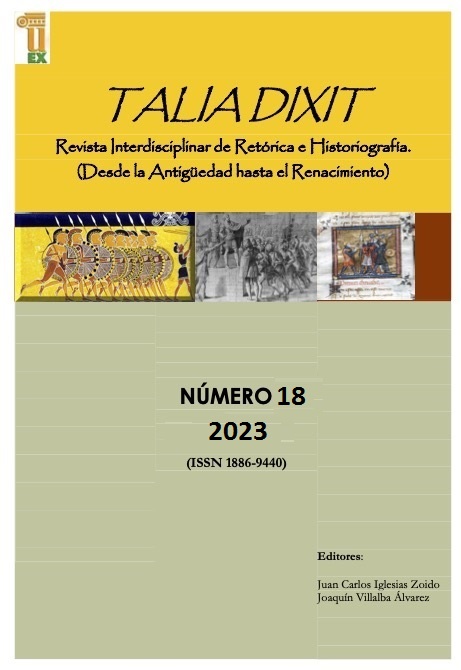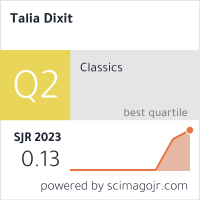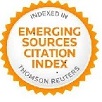Sentimientos del exilio: Análisis a dos cartas (98, 188) de Focio de Constantinopla como muestra de expresión retórica
DOI:
https://doi.org/10.17398/1886-9440.18.17Palabras clave:
Focio de Constantinopla, Cartas, Exilio, Análisis retórico, Dinastía macedónicaResumen
El corpus epistolar de Focio de Constantinopla (c. 810-893 AD) sobresale no solo por su tamaño (solo segunda a la de Teodoro Estudita en la época bizantina), sino también por los destinatarios y remitentes, entre los cuales se encuentran Miguel III (842-867), Basilio I (867-886), Ašot I de Armenia (c. 820-890) y Boris I de Bulgaria (m. 907). Además, una cantidad considerable de estas cartas fue escrita durante el exilio que padeció en el 867 a raíz de los conflictos con el papado y los ignacianos, lo cual nos permite explorar su sentir durante este periodo. El objetivo de este trabajo es efectuar el análisis retórico a dos cartas importantes (98, 188) con el fin de examinar tanto el carácter (êthos) con el cual se presenta Focio a sus destinatarios, como la estructura y recursos empleados en ellas.
Descargas
Referencias
Fuentes
Chrysostomus, Adversus oppugnatores vitae monasticae [Chrys. Adv. opp. vit. Mon.]; Ad Stagirium [Ad. Stag.] = Migne, Jacques (ed.) (1863), Joannis Chrysostomi archiepiscopi Constantinopolitani, opera omnia quae extant, tomi primi pars prior (Patrologiae Cursus Completus: Series Graeca 47). París: J.P. Migne.
Chrysostomus, De consubstantiali [Chyrs. De Cons.] = Migne, Jacques (ed.) (1862), Joannis Chrysostomi archiepiscopi Constantinopolitani, opera omnia quae extant, tomi primi pars posterior (Patrologiae Cursus Completus: Series Graeca 48). París: J.P. Migne.
Chrysostomus, In Ioannem [Chyrs. In Ioann.] = Migne, Jacques (ed.) (1862), Joannis Chrysostomi archiepiscopi Constantinopolitani, opera omnia quae extant, tomus octavus (Patrologiae Cursus Completus: Series Graeca 59). París: J.P. Migne.
Georgius Monachus, Chronographia [Georg. Mon.] = Migne, Jacques (ed.) (1863), Georgii Monachi Chronicon breve: lib. 1-6 (Patrologiae Cursus Completus: Series Graeca 110). París: J.P. Migne.
Menologium Basilianum [Men.] = Migne, J. (ed.) (1894), Menologium Basilianum (Patrologiae Cursus Completus Series Graeca 117), París: J.P. Migne.
Nicetas David, Vita Ignatii [V. Ignat. S.] = Smithies, Andrew (ed.) (2013), The Life of Patriarch Ignatius (Corpus Fontium Historiae Byzantinae. Series Washingtonensis 51) Washington, D.C.: Dumbarton Oaks.
Novum Testamentum [N. T.] = Aland, K. et. al. (eds.) (2012), Novum Testamentum Graece, Stuttgart: Deutsche Bibelgesellschaft.
Photius, Bibliotheca [Phot. Bibl.] = Henry R. (ed.) (1959-1977), Bibliothèque, texte établi et traduit René Henry, Paris: Les Belles Lettres, 8 vols. (I: 1959; II: 1960; III: 1962; IV: 1965; V: 1967; VI: 1971; VII: 1974; VIII: 1977).
Photius, Epistulae [Phot. Ep.] = Laourdas, B. y L. G. Westerink (eds.) (1983-1985), Photii patriarchae Constantinopolitani Epistulae et Amphilochia (Bibliotheca Scriptorum Graecorum et Romanorum Teubneriana), Leipzig: Teubner, 3 vols [1: 1983; 2: 1984; 3: 1985].
Photius, Lexicon [Phot. Lex.] = Theodoridis, Christos (ed.) (1982, 1998, 2013), Photii Patriarchae Lexicon, Berlin: De Gruyter, 3 vols.
Photius, Mystagogia [Phot. Myst.] = Alexopoulos, T. (ed.) (2023). Photios' von Konstantinopel "Mystagogie des Heiligen Geistes": Übersetzung und theologischer Kommentar, Berlin y Boston: De Gruyter.
Plato, Apologia [Pl. Ap.] = Burnet, J. (ed.) (1900), Platonis opera, Oxford: Clarendon Press, vol. 1.
Plato, Critias [Pl. Criti.] = Burnet, J. (ed.) (1902), Platonis opera, Oxford: Clarendon Press, vol. 4.
Polybius, Historiae [Plb.] = Büttner-Wobst, T. (ed.) (1889-1905), Polybii historiae, Leipzig: Teubner, 4 vols. [1:1905; 2:1889; 3:1893; 4:1904].
Pseudo-Symeon [Ps. Sym] = Bekker, Immanuel (ed.) (1838), Theophanes Continuatus, Ioannes Cameniata, Symeon Magister, Georgius Monachus (Corpus Scriptorum Historiae Byzantinae), Bonn: Weber.
Symeon Magister [Sym. Mag.] = Wahlgren, S. (ed.) (2006), Symeonis Magistri et Logothetae Chronicon (Corpus Fontium Historiae Byzantinae: -Series Berolinensis 44/1), Berlin y New York: De Gruyter.
Symeon Logothetes [Sym. Log.] = Wahlgren, Stephen (ed.) (2006), Symeonis Magistri et Logothetae Chronicon (Corpus Fontium Historiae Byzantinae: Series Berolinensis 44/1), Berlin: De Gruyter.
Synaxarium Constantinopolitanum [Syn. Cpl.] = Delehaye, H. (ed.) (1902), Synaxarium ecclesiae Constantinopolitanae e codice Sirmondiano nunc Berolinensi (Acta Sanctorum 62). Bruselas: Socios Bollandianos.
Theophanes Continuatus [Theoph. Cont.] = Featherstone J. M. y J. Signes-Codoñer (eds.) (2015), Chronographiae quae Theophanis Continuati nomine fertur Libri I-IV. Recensuerunt anglice verterunt indicibus instruxerunt Michael Featherstone et Juan Signes-Codoñer, nuper repertis schedis Caroli de Boor adiuvantibus (Corpus Fontium Historiae Byzantinae– Series Berolinensis 53), Berlin y Boston: De Gruyter.
Vetus Testamentum [V. T.] = Rahlfs, A. (ed.) (1935), Septuaginta. Stuttgart: Württemberg Bible Society, 2 vols.
Estudios
Alexopoulos, T. (2014), “Areopagitic influence and neoplatonic (Plotinian) echoes in Photius’ Amphilochia: question 180”, Byzantinische Zeitschrift 170.1: 1-36.
Anthopoulou, T. (1997), The Homilies of the Emperor Leo VI (The Medieval Mediterranean 14), Leiden y Boston: Brill.
Arcos Pereira, T. (1992), “Los códices Scorialensis g-III-2 y Toletanus 49-16 de Cornelio Nepote”, Cuadernos de Filología Clásica. Estudios Latinos 2: 19-40.
Auzépy, M.-F. (2019), “State of emergency (700–850)”, en The Cambridge History of the Byzantine Empire c. 500-1492, Revised Edition, Cambridge: Cambridge University Press, pp. 251-291.
Barry, J. (2019), Bishops in Flight: Exile and Displacement in Late Antiquity, California: University of California Press.
Brubaker, L. y J. Haldon (2011), Byzantium in the iconoclast era, c. 680-850: a history, Cambridge: Cambridge University Press.
Canfora, L. (2000), “Il rogo dei libri di Fozio”, en G. Menestrina (ed.), Fozio. Tra crisi ecclesiale e magisterio letterario, Brescia: Morcelliana, pp. 17-28.
Chadwick, H. (1955), “The Exile and Death of Flavian of Constantinople: A Prologue to the Council of Calchedon”, The Journal of Theological Studies 6.1: 17-34.
_______ (2003), East and West. The Making of a Rift in the Church, Oxford: Oxford University Press.
Dvornik, F. (1970), The Photian Schism: History and Legend. Cambridge: Cambridge University Press.
Garland, L. (2011), Byzantine Empresses: Women and Power in Byzantium AD 527-1204, Londres: Routledge.
Gregory, T. (2009), A History of Bizantium, Chichester: Wiley-Blackwell.
Grünbart, M. (2005), Formen der Anrede im byzantinischen Brief vom 6. bis zum 12. Jahrhundert (Wiener Byzantinistische Studien 25), Vienna: Verlag der Österreichischen Akademie der Wissenschaften.
_______ (2021), Epistularum Graecarum Initia usque ad annum MD, Hildesheim-Zürich-New York: Olms-Weidmann.
Humphreys, M. (2021), “Contexts, Controversies, and Developing Perspectives”, A Companion to Byzantine Iconoclasm, Leiden y Boston: Brill, pp. 1-108.
Hussey, J. (2010), The Orthodox Church in the Byzantine Empire (Oxford History of the Christian Church), Nueva York: Oxford University Press.
Ibáñez-Chacón, A. (2021), “Uno schedarion, due rielaborazioni”, Jahrbuch der Oesterreichischen Byzantinistik, 71: 259-268.
Jeffreys, E. (2001), “Introduction”, en Jeffreys E. (ed.), Rhetoric in Byzantium. Papers from the Thirty-fifth Spring Symposium of Byzantine Studies, Exeter College, University of Oxford, March 2001, Aldershot: Ashgate, pp. 1-5.
Kazhdan, A. P. (2006), A history of Byzantine literature: 850-1000, edited by Christine Angelidi, Athens: National Hellenic Research, Institute for Byzantine Research, vol. 2.
Kolbaba, T. M. (2021), “The Patriarchate and the Western Church to 1204”, en C. Gastgeber, E. Mitsiou, J. Preiser-Kapeller, V. Zervan (eds.), A Companion to the Patriarchate of Constantinople, Leiden y Boston: Brill, pp. 42-62.
LBG = Trapp, E., et al. (1994-2017), Lexikon zur byzantinischen Gräzität, besonders des 9.–12. Jahrhunderts (LBG),Wien: Die Österreichische Akademie der Wissenschaften, 8 vols.
Lemerle, P. (2017), Byzantine Humanism: The first phase, notes and remarks on education and culture in Byzantium from its origins to the 10th century. (transl. by Lindsay Helen and Ann Moffat), Leiden y Boston: Brill.
Leonte, F. (2023), Ethos, Logos, and Perspective. Studies in Late Byzantine Rhetoric, London y New York: Routledge.
Limousin, E. (1999), “Les lettrés en société: «φίλος βίος» ou «πολιτικὸς βίος»?”, Byzantion 59.2: 344-365.
Littlewood, A. R. (1999), “The Byzantine Letter of Consolation in the Macedonian and Komnenian Periods”, Dumbarton Oaks Papers 53:19-41.
LSJ = Liddel H., G. R. Scott y H. S. Jones (eds.) (1996), Greek-English Lexicon, Oxford: Clarendon Press.
Mango, C. (1958), The Homilies of Photius, Patriarch of Constantinople: English Translation, Introduction and Commentary, Cambridge: Harvard University Press.
Markopoulos, A. (2004), “New Evidence on the Date of Photios’ Bibliotheca”, en History and Literature of Byzantium in the 9th-10th Centuries, Aldershot: Ashgate, pp. 1-18.
Mazzucchi, C. M. (2021), “Restauro e interpretazione dell'epistola a Tarasio”, Aevum 14.2: 441-464.
Mullet, M. (1999), “Friendship in Byzantium: Genre, topos and network”, en Friendship in Medieval Europe, Stroud: Sutton Publishing, pp. 166-184.
Norwich, J. J. (1998), A Short History of Byzantium, New York: Vintage Books.
Papadopoulou P. y Casas-Olea, M. (2020), “Patriarca Focio”, en Casas-Olea, M. (coord.), Fuentes griegas sobre los eslavos II. Cristianización y formación de los primeros Estados eslavos (2 Fuentes epigráficas, epistolares, hagiográficas), Granada: Centro de Estudios Bizantinos, Neogriegos y Chipriotas, pp. 62-124.
Polidori, V. (2018), La Mistagogia del Santo Spirito, Edizione critica con testo a fronte, edizione critica, Roma: Carocci.
Pontani, F. (2020), “Scholarship in the Byzantine Empire (529–1453)”, en History of Ancient Greek Scholarship: From the Beginnings to the End of the Byzantine Age, Leiden y Boston: Brill, pp. 373-529.
Prieto-Domínguez, O. (2008), “Problemas de cronología relativa en dos corpora del patriarca Focio: Epistulae y Amphilochia”, Medioevo Greco 8: 255-270.
________ (2010), “El partido ignaciano: estructuración en el exilio y superviviencia tras la muerte del patriarca Ignacio I”, El futuro del Pasado 1: 379-393.
________ (2013), “La preceptiva epistolar en Bizancio: las normas vigentes según el patriarca Focio”, Medioevo Greco 13: 177-203.
_______ (2020), Literary Circles in Byzantine Iconoclasm: Patrons, Politics and Saints, Cambridge: Cambridge University Press.
RAE = Diccionario de la lengua española, Madrid: Real Academia de la Lengua Española, 23ª edición [en línea] https://dle.rae.es/exilio [10/10/2023].
Riedel, M. (2018), Leo VI and the transformation of Byzantine Christian identity: writings of an unexpected emperor, Cambridge: Cambridge University Press.
_______ (2021), “Photios’s Hermeneutic for Wisdom Literature in Amphilochia 9”, en R. Ceulemans y B. Crostini (eds.), Receptions of the Bible in Byzantium: Texts, Manuscripts, and their Readers (Acta Universitatis Upsaliensis, Studia Byzantina Upsaliensia 20), Uppsala: Uppsala University Library, pp. 91-106.
Riehle, A. (2020), “Introduction: Byzantine Epistolography: a Historical and Historiographical Sketch”, en A Companion to Byzantine Epistolography (Brill’s Companions to the Byzantine World 7), Leiden y Boston: Brill, pp. 1-32.
Ronconi, F. (2014), “Pour la datation de la Bibliothèque de Photius. La Myriobiblos, le Patriarche et Rome”, en Juhász E. (ed.), Byzanz und das Abendland II. Studia Byzantino-Occidentalia, Budapest (Antiquitas, Byzantium, renascentia 2), Budapest: Eötvös-József-Collegium, pp. 135-153.
_______ (2015), “Il moveable feast del Patriarca. Note e ipotesi sulla genesi della Bibliotheca di Fozio”, en L. del Corso, F. de Vivo y A. Stramaglia (eds.), Nel segno del testo. Edizioni, materiali e studi per Oronzo Pecere, Firenze: Gonnelli, pp. 203-238.
Salvemini, R. (1997), “Aspetti letterari dell’Epistolario di Fozio”, Annali Della Facoltà di Lettere e Filosofia. Università degli Studi di Bari 40:191-208.
Schamp, J. (2008), “Photios, maître de l’art épistolaire”, en P. Laurence y F. Guillaumont (eds.), Epistulae Antiquae V. Actes du V Colloque international «L'épistolaire antique et ses prolongements européens», Louvain, Paris y Dudley (Mass): Peeters, pp. 309-325.
Schoolman, E. M. (2016), Rediscovering Sainthood in Italy: Hagiography and the Late Antique Past in Medieval Ravenna, New York: Palgrave-Macmillan.
Signes-Codoñer, J. (2017), “Hacia un inventario de las obras de Focio”, Estudios Bizantinos, 5.1:61-90.
Signes-Codoñer, J. y F. J. Andrés-Santos (2007), La introducción al derecho (Eisagoge) del patriarca Focio (Nueva Roma 28), Madrid: Consejo Superior de Investigaciones Científicas.
Stathakopoulos, D. (2014), A Short History of the Byzantine Empire, Londres: Bloomsbury Academic.
Stephanou, P. (1951) “La violation du compromis entre Photius et les Ignatiens”, Orientalia Christiana Periodica 21: 291-307.
Strano, G. (2007), “Il tema dell’esilio negli epistolari bizantini del IX-X sec.: realtà e topos letterario”, Bizantinistica 9: 175-193.
_______ (2010),”Forme e significati dei riferimenti alle eresie nell’epistolario di Fozio”, Rivista di Studi Bizantini 47:177-194.
_______ (2018), “Lo spazio delle passioni nelle epistole bizantine dall’esilio”, en Cipolla P. B, C. Crimi, R. Gentile, L. Giordano y A. Rotondo (eds.), Spazi e tempi delle emozioni: Dai primi secoli all’ età bizantina. Atti del Convegno “Progetto FIR 2014” e delle VI Giornate di Studio della CULCA, Roma: Bonanno, pp. 293-308.
Torgeson, J. W. y M. Humphreys (2021), “Chronicles, Histories and Letters”, en A Companion to Byzantine Iconoclasm, Leiden-Boston: Brill, pp. 191-229.
Tougher, S. (2019), “After Iconoclasm (850-886),” en The Cambridge History of the Byzantine Empire c. 500-1492, Revised Edition, Cambridge: Cambridge University Press, pp. 292-304.
Treadgold, W. (2001), A Concise History of Byzantium, Basingstoke: Palgrave.
_______ (2002), “Photius Before His Patriarchate”, Journal of Ecclesiastical History 53.1: 1-7.
Trono, B. (2020), “Per la storia del testo della Biblioteca di Fozio: Pinax e note redazionali”, Segno e Testo, 18:123-186.
Valiavitcharska, V. (2013), Rhetoric and Rhythm in Byzantium: The Sound of Persuasion, Cambridge: Cambridge University Press.
Varona Codeso, P. (2009), Miguel III (842-867). Construcción histórica y literaria de un reinado (Nueva Roma 33), Madrid: Editorial CSIC.
Varona Codeso, P. y O. Prieto Domínguez (2013), “Deconstructing Photios: family relationship and political kinship in middle Byzantium”, Revue des études byzantines 71: 105-148.
Vinson, M. (2001), “Rhetoric and writing strategies in the ninth century,” en Jeffreys E. (ed.), Rhetoric in Byzantium. Papers from the Thirty-fifth Spring Symposium of Byzantine Studies, Exeter College, University of Oxford, March 2001, Aldershot: Ashgate, pp. 1-5.
White, D. S. (1973), “Photios' Letter to His Brother Tarasios on the Death of His Daughter”, The Greek orthodox theological review, 18: 47-58.
_______ (1981), Patriarch Photios of Constantinople: His Life, Scholarly Contributions, and Correspondence together with a Translation of Fifty-two of His Letters, Massachusetts: Holy Cross Orthodox Press.
White, D. S., y J. R. Berrigan (1982), The Patriarch and the Prince: the letter of Patriarch Photios of Constantinople to Khan Boris of Bulgaria, Massachusetts: Brookline.
Wilson, N. G. (2000), “Fozio e le due culture. Spunti dall'epistolario”, en G. Menestrina (ed.), Fozio tra crisi ecclesiale e magistero letterario, Brescia: Morcelliana, pp. 29-44.














